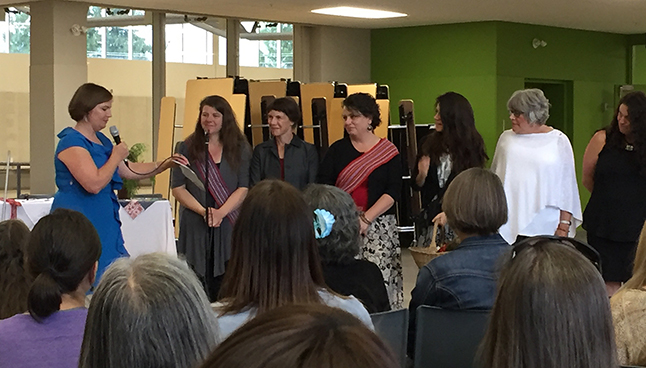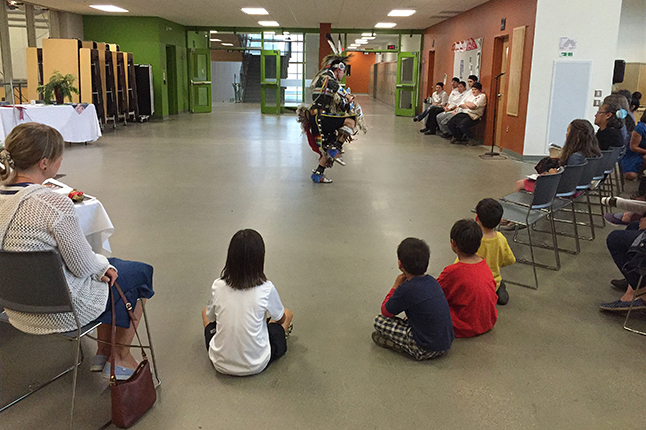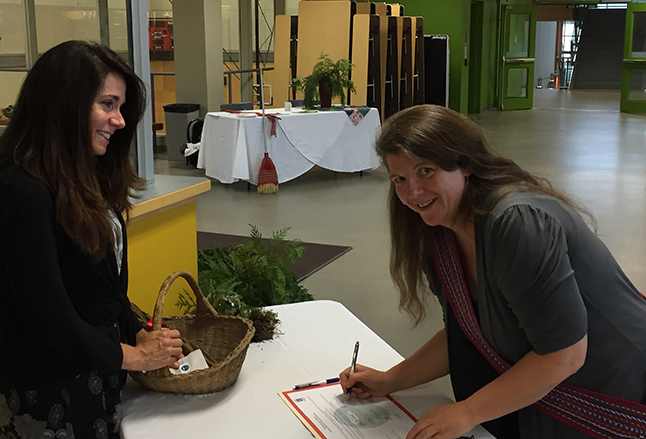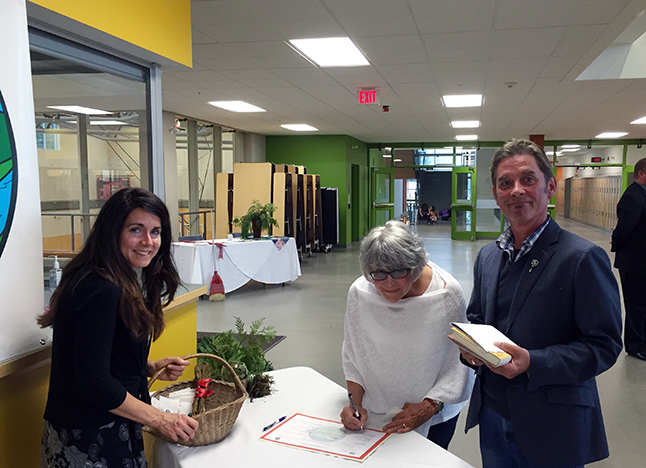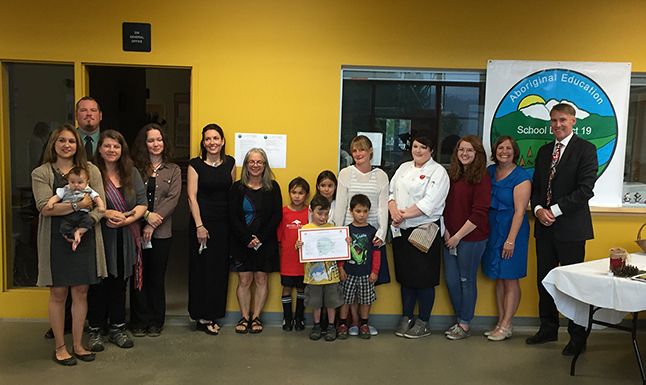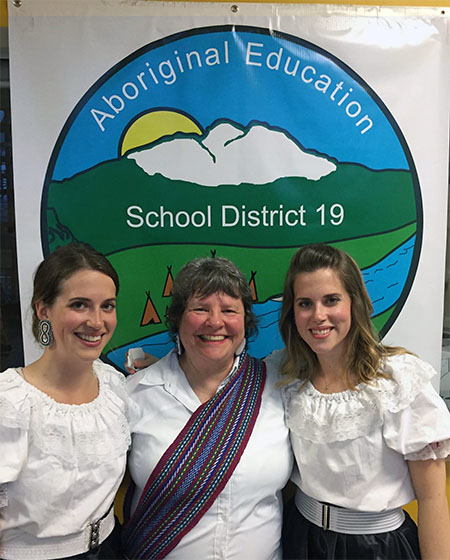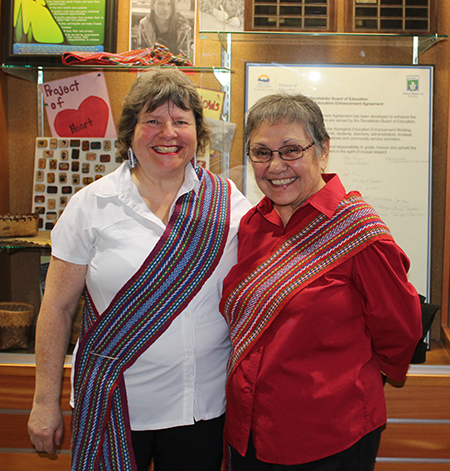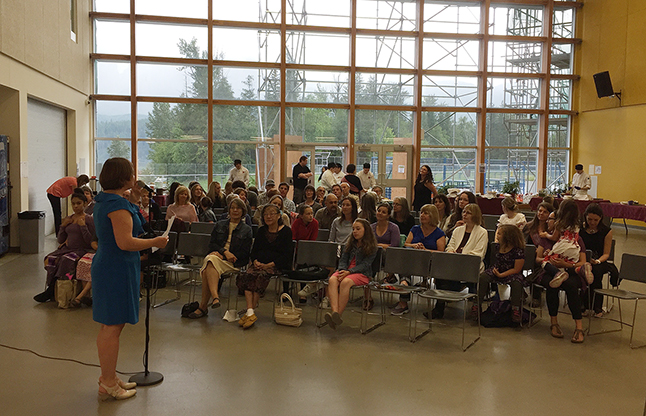
By David F. Rooney
Revelstokians gathered at RSS on Thursday, May 26, to celebrate the signing of School District 19’s second Aboriginal Enhancement Agreement.
That document represents the culmination of more than a year of consultation and collaborative planning in our community. Enhancement Agreements (EAs) are working agreements between a school district, local Aboriginal communities, and the Ministry of Education, and are designed to enhance the success of aboriginal students. For decades many — perhaps even most — native children have fared poorly in the educational system.
SD 19’s first aboriginal enhancement agreement, was signed in 2010. (Please click here to read our story about that event.) The
Some of the successes from the first Enhancement Agreement include the following:
- Aboriginal student self-identification rates have remained in the 13-14% range, with 100% of graduating students choosing to participate in the blanket or sash ceremony;
- First Nations 12 has run in our District since 2006 for all interested learners;
- District-wide aboriginal events have been held, including special performances, commemoration of the National Day for Healing and Reconciliation, sturgeon-nose canoe building, and the painting of a mural representing the First Peoples’ language regions across Canada;
- Aboriginal students are reading at grade level in District-wide measures at Grade 3 and Grade 7 (100% of students); and
- Six-year aboriginal student high school completion rate is 76%, compared with BC average of 62%; and
- Provincially mandated testing indicates results at or above the district average in writing and numeracy at Grade 7.
But while there are many successes, there are still challenges to address:
- Difficulty of connecting students with knowledgeable Aboriginal people to learn from. In particular, integrating authentic Aboriginal language learning opportunities;
- Small but persistent differences in educational outcomes for Aboriginal students, especially in the upper grades (grade-to-grade transitions, six-year high school completion rate, scholarship rate); and
- Emphasis in the curriculum on Aboriginal topics and perspectives across all grades and subject areas needs to be supported by authentic professional development and resources.
The new agreement identifies two goals:
Goal 1 — To nurture in Aboriginal students a spirit of generosity, belonging, independence, and mastery.
Rationale
We acknowledge our shared responsibility to continue to improve outcomes for Aboriginal students in Revelstoke. Our consultations with community groups and individuals revealed that success means a variety of different things to different people. The wording of this goal is based upon the work of Martin Brokenleg, whose Circle of Courage model integrates Aboriginal philosophies of child-rearing, and contemporary resilience research. This holistic approach to student success and health reflects the community responses in our consultations.
- Nurturing generosity involves opportunities for giving unselfishly back to others, and the feeling of worth and responsibility that brings;
- Belonging involves treating others as kin, forging powerful social bonds based on respect;
- Nurturing independence involves opportunities to make decisions, solve problems and show personal responsibility;
- Mastery involves learning from others with more experience to become competent and capable.
An essential part of this goal is the need to work in partnerships to build the capacity and enthusiasm among educators and staff in School District No. 19 to integrate aboriginal ways of knowing in their classrooms. Another key to the realization of this goal is to enhance connections with Aboriginal elders, knowledge keepers and community members in and around Revelstoke. With no nearby local band, these individual connections are important.
Goal 2: To integrate reconciliation and Aboriginal ways of knowing across all grades for all learners.
Rationale
The deep history of our continent and our country is that of Aboriginal history and cultures. Knowledge of Aboriginal culture and history can expand the world views of all students, foster inclusivity and tolerance, and contribute to the values acknowledged as central in the work of the Truth and Reconciliation Commission — honouring all peoples in Canada, regardless of ancestry, and nurturing a strong and resilient culture for all. Aboriginal cultural studies and history, both past and present, can foster humility and understanding in all learners as they develop broad understandings of different ways of knowing, believing and living.
Destination — Reconciliation and the way forward:
- To learn about the legacy of colonialism in Canada;
- To learn about the local area in which we live: it’s first peoples, and the languages, land and organisms which continue to sustain us; and
- To learn about the contributions, historic and contemporary, of Aboriginal peoples.
Elements — schools and the School District as a whole strive to:
- Educate staff, teachers and administrators in Aboriginal perspectives;
- Familiarize staff, teachers and administrators of the District with the recommendations of the Truth and Reconciliation Commission;
- Implement the revised Provincial curriculum, including the use of authentic aboriginal resources across grades and subject areas;
- Provide anti-racism education opportunities;
- Encourage the use of territorial acknowledgement protocols at appropriate times or events;
- Empower teachers to facilitate cultural opportunities in their classrooms;
- Include in the elementary curriculum both historical and contemporary information about the local first peoples of this area, including meeting representatives from each of these Nations;
- Endorse plant walks and ethnobotany study, following protocols for sustainable and respectful use;
- Endorse curriculum projects that sustain a view of “Helping all the animals in the world” (Primary student’s words); Eco-biological studies and
- Create awareness for all students of local Aboriginal languages through signage, posters, and knowledge of simple greetings.
The growing number of successes being experienced by aboriginal students not only help bootstrap them towards a bright future as productive adults, they will doubtless level the playing field and alter the way non-natives regard them. That’s important. The gaps that exist between Canadians of native and non-native backgrounds can only be bridged when all of us regard ourselves and each other respect and understanding.
When asked about the agreement’s prospects for continuing success, Ariel McDowell, SD19’s district principal for Aboriginal Education said: “I think the words in our Enhancement Agreement say it best, ‘We envision a student body and staff who understand indigenous history and circumstances, and recognize our roles as individuals and institutions in reconciliation, ensuring that Aboriginal students are successful and confident in their endeavours; who feel connected to their cultural heritage; and recognize their unique gifts, strengths and abilities. We are committed to a community that acknowledges, honours and respects the diverse cultures of Aboriginal students, families and elders.’ That’s our work, and we look forward to continuing it.”
Please click on the following links for more information:
http://www.sd19.bc.ca/aboriginal-education/
http://www.sd19.bc.ca/wp-content/uploads/sites/2/2015/03/14-15-Ab-Ed-Annual-Report.pdf
Here are some additional photos from this event:

